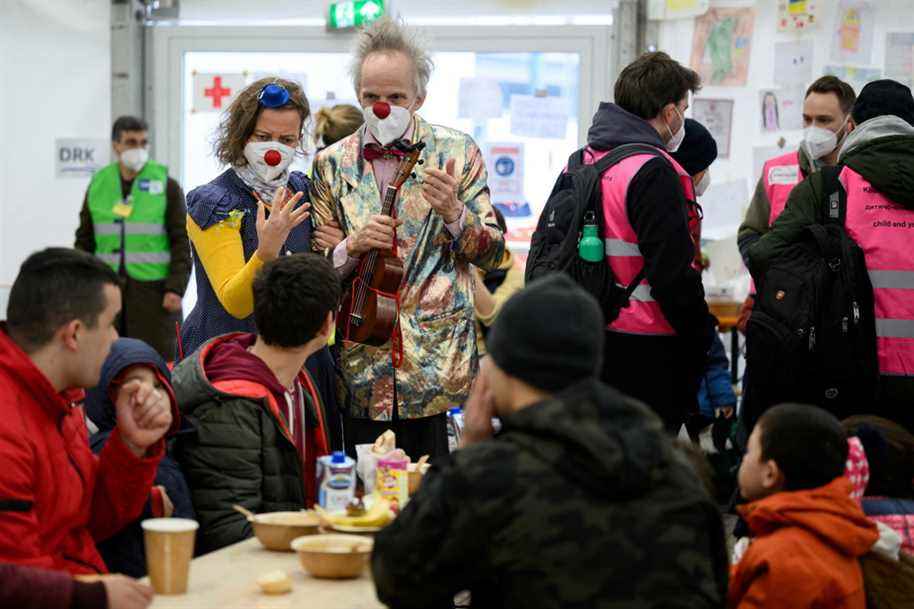The scene takes place on the border of Ukraine and Moldova. Under the scattered snowflakes, a child and his family go through customs. Then a clown appears in front of them, pretending to offer a lollipop, before changing his mind at the last moment. Ten seconds later, laughter breaks out. The cold, the fatigue, the armed guards, the fear of bombs and the unknown… everything is forgotten. If only for a moment. A look at those who sow laughter in times of war.
Posted at 5:43 p.m.
Since the beginning of the Russian invasion in Ukraine, at least 1.4 million children have left the country, estimates UNICEF. Thousands of humanitarian workers welcomed them in neighboring countries, along with their relatives. Among them, at the border, but also in shelters, train stations or buses, clowns, such as those from the Israeli organization The Dream Doctors, whose “antics” were captured by the American journalist Andrew Kimmel, also allowed to laugh a little.
Spanish clown Nacho Camarero is in Warsaw, Poland, with a small team of artists from Clowns Without Borders who are touring train stations and depots, where refugees are crammed in by the thousands. On the beds which form improvised camps, the faces are eaten away by worry, he says on the telephone Thursday evening: “When the children sleep, you can see it in their faces that they are suffering. »
But as soon as the little troupe starts juggling, dancing, doing acrobatics and playing music, the atmosphere changes completely.
It laughs, it claps, it’s so beautiful to see all these children laughing in unison. The other day, a 6-year-old girl suddenly got up after the performance to give each of us a hug, a smile from ear to ear. It was wonderful. She told us: “I want to be like you. I want to become a clown too.”
Nacho Camaro
“I don’t save lives, but I feel that I am doing useful work, that my talent is useful when I give emotional and psychological support. It’s very rewarding, I really like it,” adds the man who has been volunteering with the organization since 2011, and who has made refugees laugh in Jordan, Lebanon, Greece, Colombia and Bosnia in particular.
The scale of the current refugee crisis in Eastern Europe has upset Nacho Camarero. “In 2015, we worked a lot with children from Syria, but also from Iraq, Afghanistan and elsewhere who arrived in Europe. Today’s situation reminds us a lot of that, but this time, with 3 million refugees in just a few days, it’s really disturbing. And sometimes difficult. “It’s very demanding, and not everyone understands what we’re doing. Tonight, the police and a station master kicked us out. But I can’t blame them, it’s so chaotic here. »
Still, the work of clowns strikes a chord with many people. The video described at the beginning of this text has been viewed more than 1.2 million times since it was posted on Twitter on March 12. And it aroused a lot of emotion. “The sound of their laughter brought me to tears,” wrote one user. “They bring tears, joy, sadness, laughter in the midst of madness. Thanks for them ! “adds another.

PHOTO PROVIDED BY CLOWNS SANS FRONTIÈRES
Spanish clowns are touring train stations and camps in Poland these days.
A real need
Of course, we must first feed the refugees and give them a roof, but the work of therapeutic clowns meets a real need, explains Katel Le Fustec, general and artistic director of Clowns Without Borders Canada.
“These people went through bombardments, they left everything, recalls Mme The Fustec, the voice knotted by emotion. For the children – and not only them – there is an accumulated stress, and this grain of madness, it allows you to have a break, a little perspective. Laughing together and chasing stress to bounce back better is what clowns provide in addition to all essential services. »
Clowns Without Borders was born from the work of Catalan clown Tortell Poltrona, who saw the power of laughter in the former Yugoslavia in 1993. In addition to the Spanish team, British clowns will soon be traveling to Poland and then to Romania . The Canadian branch of the movement, founded in 1994, is also evaluating the possibility of sending artists to Eastern Europe in the coming weeks.
On site, the artists try to monopolize as few resources as possible. The teams are small, mobile and autonomous, and must respect a code of ethics. “The work on the ground is super emotional and it’s super physical, specifies Mme The Fustech. And the artists are not there to promote their career, they have to get involved in the association and offer their art for free. The whole operation is financed by our funds. »
Since its creation, Clowns Without Borders Canada has carried out projects in Haiti, Senegal, Ivory Coast and Chile, among others, but also in Montreal, particularly with isolated elderly people in CHSLDs and children newly arrived in Quebec. .
Learn more
-
- 73,000
- About 73,000 children leave Ukraine every day to find refuge abroad.
SOURCE: UNICEF

